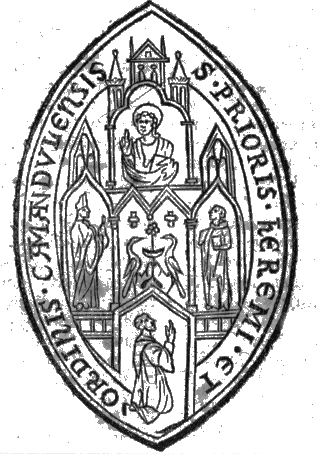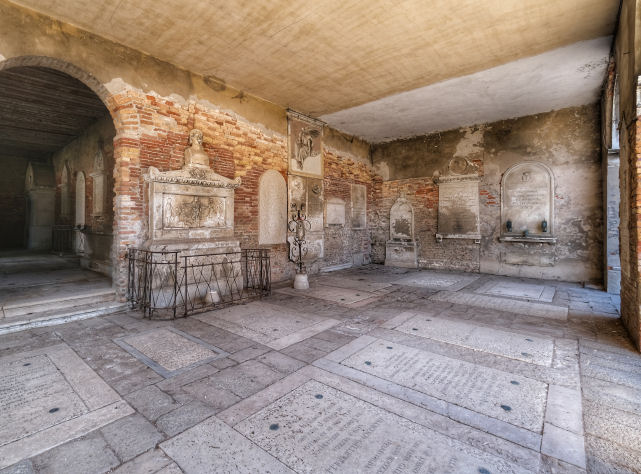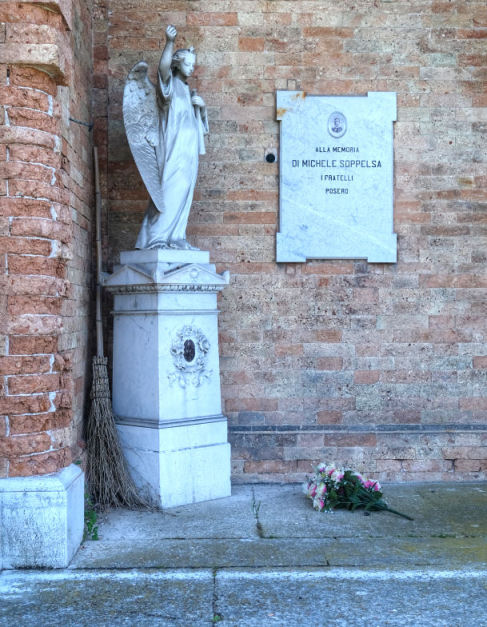San Michele in Isola
&
The Cemetery
 History HistoryThe original church was founded in the 10th century and dedicated to to the Archangel Michael. A monastery was built too and housed monks of the Camaldolesi order from 1212 to 1818. Amongst the monks who lived here were Fra Mario Capellari, who became Pope Gregory XVI, and famed cartographer Fra Mauro - there's a Fra Mauro Crater on the Moon named after him. (See far below right for an image of his mappamundo.) The church was enlarged and consecrated in 1221. Rebuilt in its current form 1469-78 by Mauro Codussi, who had previously worked for the Camaldolesi in Ravenna. This was his first building in Venice, begun when he was in his late 20s, and Venice's first church in the Renaissance style. The design of the façade and its use of Istrian stone solely was very influential on Venetian church architecture. The hexagonal Cappella Emiliana (see photo right) to the left of the façade was funded by the will of Margherita Vitturi, the widow of Giovanni Emiliani, who was the son of Bishop Pietro Emiliani of Vicenza who has a monument in the Frari. Thomas Coryate in his Crudities of 1608 describes Margherita, who was the sister of humanist Daniele Vitturi, as a 'rich courtesan' who 'hoped to make expiation unto God by this holy deed for the lascivious dalliances of her youth'.) It was built 1529 to c.1535 by Guglielmo dei Grigi and repaired by Sansovino in 1560-62. The gothic doorway to the right of the façade leads to a 15th century cloister (see photo below right). In 1835-39 the wide canal which divided the islands of San Michele and San Cristoforo was filled in to enlarge the cemetery founded on the latter island by Napoleon in 1807 (see below) and the monastery here passed to reformed Franciscans. Interior Restrained and basilical, with flat coffered ceiling and a gallery (see photo right.) There's a modest monument inside the vestibule (with his ashes) to Paolo Sarpi. Also a monument to Andrea Loredan, a benefactor, in the chancel. Ruskin wrote The little Cappella Emiliana at the side of it has been much admired, but it would be difficult to find a building more feelingless or ridiculous. It is more like a German summer-house than a chapel, and may be briefly described as a bee-hive set on a low hexagonal tower, with dashes of stonework about its windows like the flourishes of an idle penman. The cloister of this church is pretty; and the attached cemetery is worth entering, for the sake of feeling the strangeness of the quiet sleeping ground in the midst of the sea. Campanile 40m (130ft) electromechanical bells Built between 1546 and 1560, an unusually complex design in brick with relief decoration and a terracotta lantern and dome with a stone pinnacle. Lost art A lot of Bellinis have passed this way! The Priuli Triptych of 1510-12 (see below) was painted for the Chapel of the Cross here, built for Pietro Priuli, who died in 1493. The central panel of the Virgin and Child is flanked by two panels - Saint Peter and a Camaldolese monk on the left, Saint Mark and another monk, plus the kneeling donor, on the right. It's a work that always had and studio added to Bellini's name, and some recent scholarship has given it to Bellini's friend and collaborator Vittore Belliniano. It's now in the Kunstpalast in Düsseldorf.
The very landscape-dominated,
Flemish-influenced, but oddly incoherent, Resurrection by him
(with worryingly giant rabbits, supposedly symbolising life; and a
cormorant, symbolising death) now in the
Gemäldegalerie in Berlin, was painted for Marco Zorzi's chapel
here in 1476. And his Virgin with Doge Agostino Barbarigo was moved here
from the Doge's Palace in 1501 - it's now in San Pietro Martire on Murano.
|
|
|
|
The Cemetery |
||
|
|
||
|
|
|
|
 
|
||

Home
Cannaregio ::
Castello :: Dorsoduro ::
Giudecca :: San Marco ::
San Polo :: Santa Croce
:: The Islands :: Demolished